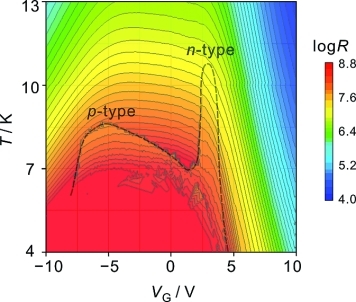Ambipolar operation of organic Mott-FET
k-(BEDT-TTF)Cu[N(CN)2]Cl (k-Cl) is a Mott-insulator with larger Mott gap than k-Br and is therefore suitable for examining the influence of an increase in Mott-gap energy on the device performance. For example, it has higher resistance than k-Br and exhibit better ON/OFF ratio. In addition, it always shows ambipolar behavior, probably because of its clean surface (Figure 3). This situation allows us to analyze the critical exponents of filling-controlled Mott transition, which will give us important information about ON/OFF efficiency of the device. Because it is also possible to control the Mott gap energy by applying a mechanical strain, k-Cl device provides an ideal platform to expand Mott-FET strategy to higher temperature.


- H. M. Yamamoto, Y. Kawasugi, H. Cui, M. Nakano, Y. Iwasa, and R. Kato,
Asymmetric Phase Transitions Observed at the Interface of a Field-Effect Transistor Based on an Organic Mott Insulator
Euro. J. Inorg. Chem., 2014, 3841–3844 (2014) - H. M. Yamamoto, J. Ueno and Reizo Kato
Critical behavior of a filling-controlled Mott-transition observed at an organic field-effect-transistor interface
Eur. Phys. J. Special Topics 222, 1057–1063 (2013) - Yoshitaka Kawasugi, Kazuhiro Seki, Yusuke Edagawa, Yoshiaki Sato, Jiang Pu, Taishi Takenobu, Seiji Yunoki, Hiroshi M. Yamamoto, and Reizo Kato,
Electron–hole doping asymmetry of Fermi surface reconstructed in a simple Mott insulator
Nature Commun., 7, 12356 (2016)